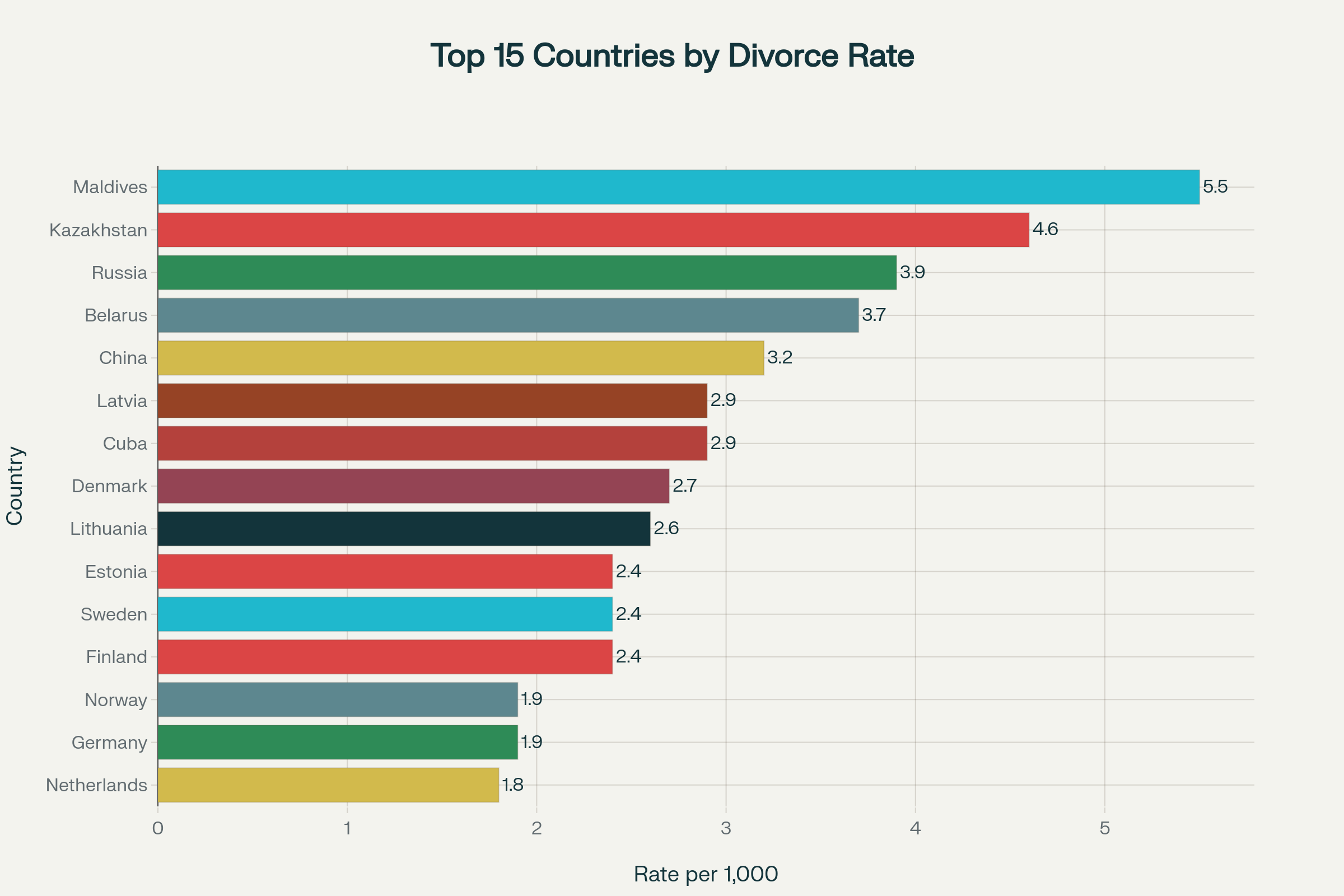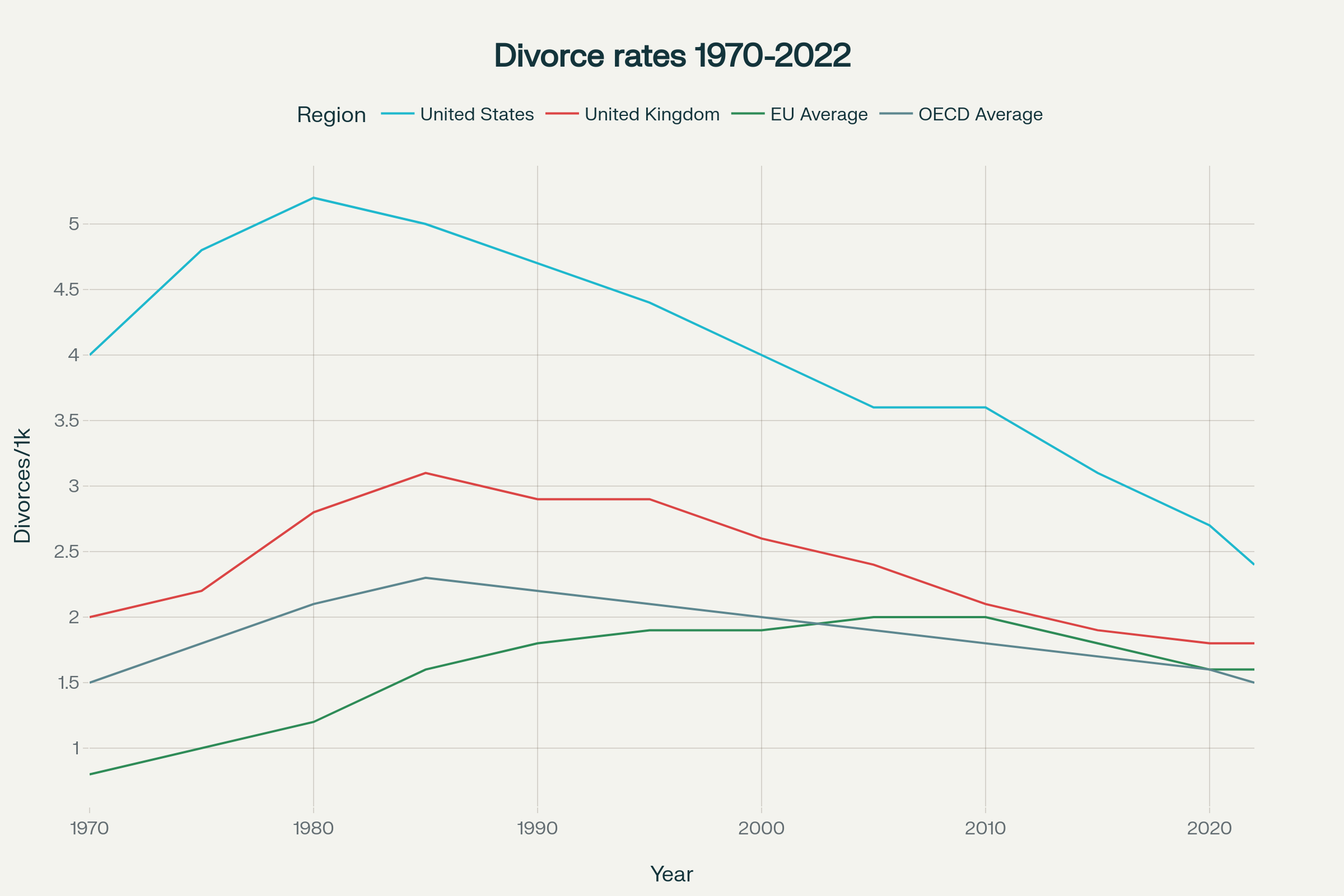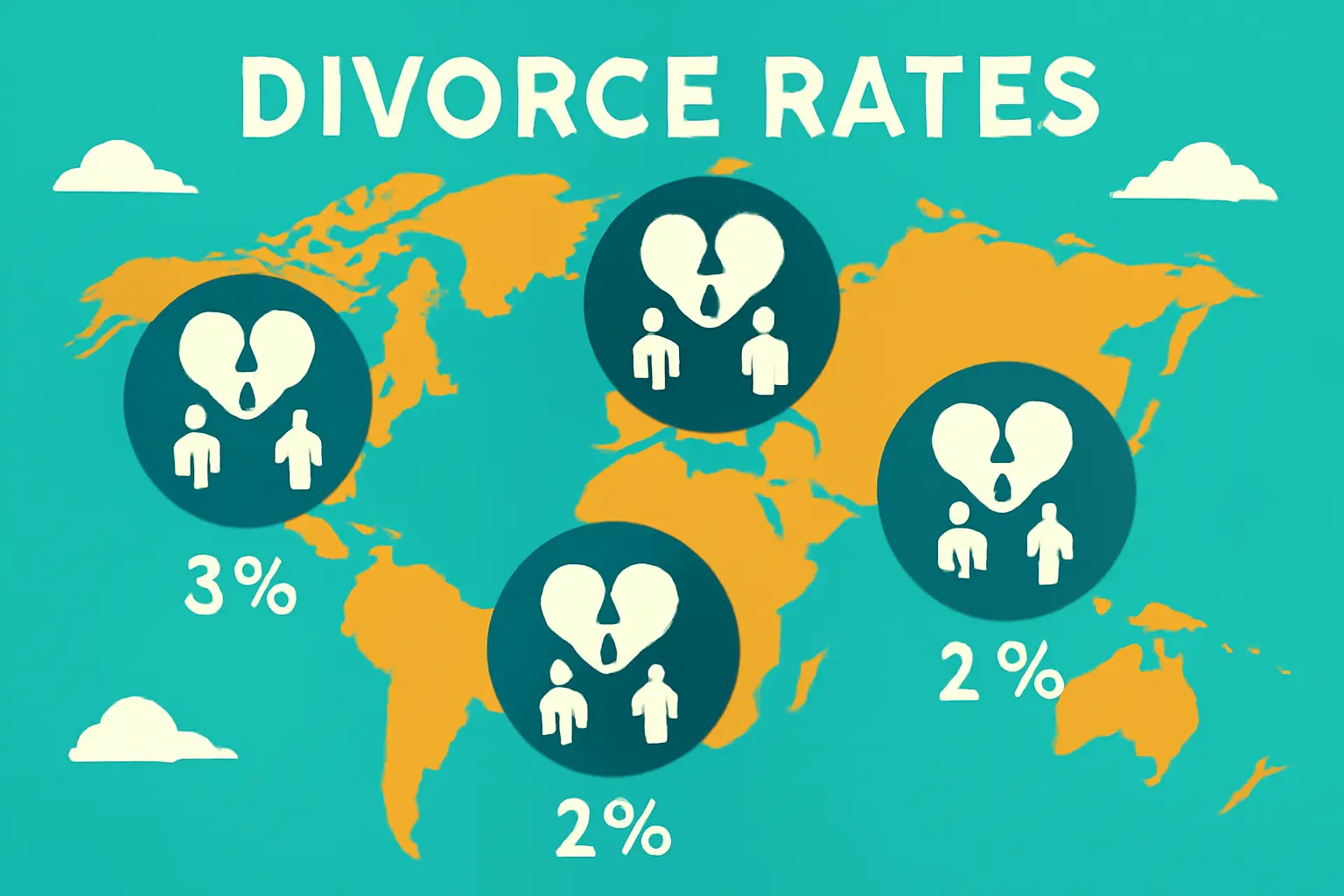The landscape of marriage and divorce has undergone dramatic transformations over the past half-century, with divorce rates varying significantly across countries, cultures, and economic conditions. Understanding global divorce patterns provides crucial insights into societal changes, economic factors, and cultural shifts that continue to shape family structures worldwide.
Global Overview and Current Statistics
The worldwide average divorce rate currently stands at approximately 1.6 to 1.8 divorces per 1,000 people annually, though this figure masks considerable variation between nations and regions. Divorce rates have generally stabilized or declined in many developed countries after reaching peaks in the 1980s and 1990s, while some developing nations continue to experience gradual increases as social norms evolve and legal frameworks become more accessible.
The global pattern reveals stark contrasts between different regions and cultural contexts. Western societies traditionally maintain higher divorce rates compared to Asian, African, and Latin American countries, though these patterns are slowly shifting due to globalization, urbanization, and changing social attitudes.
Countries with Highest and Lowest Divorce Rates
Highest Divorce Rates Globally
The countries with the most significant divorce rates present an interesting mix of developed and developing nations, each with unique contributing factors.

Countries with the Highest Divorce Rates Globally (Per 1,000 People)
The Maldives leads globally with 5.5 divorces per 1,000 people, a rate that has historical roots dating back decades. This island nation previously held the Guinness World Record for highest divorce rates at nearly 11 divorces per 1,000 people in 2002. The high rate stems from several factors: simplified divorce procedures, increased financial independence among women, and reduced social stigma surrounding divorce.
Kazakhstan follows with 4.6 divorces per 1,000 people, influenced by factors including family interference in marriages, changing social attitudes, and easy divorce processes. Russia and Belarus complete the top tier with rates of 3.9 and 3.7 respectively, reflecting post-Soviet social transformations and economic pressures.
Lowest Divorce Rates Globally
Conversely, several countries maintain remarkably low divorce rates, often influenced by strong cultural traditions, religious beliefs, and social structures.

Countries with the Lowest Divorce Rates Globally (Per 1,000 People)
India maintains the world’s lowest divorce rate at just 0.1 per 1,000 people, with only about 13 out of every 1,000 marriages ending in divorce. This reflects deep-rooted cultural values, arranged marriage traditions, strong family pressure against divorce, and social stigma associated with marital dissolution.
Sri Lanka, Vietnam, and several Latin American countries including Chile, Colombia, and Mexico also maintain relatively low rates, influenced by Catholic traditions, collectivist cultural values, and legal frameworks that historically made divorce difficult to obtain.
Historical Trends and Patterns
Five-Decade Evolution
Divorce rates have followed distinct patterns across different regions since the 1970s, with most developed nations experiencing similar trajectories of growth followed by stabilization or decline.

Global Divorce Rate Trends Over Time (1970-2022)
The United States exemplifies the typical Western pattern: divorce rates climbed from 4.0 per 1,000 in 1970 to a peak of approximately 5.3 in 1981, before gradually declining to 2.4 per 1,000 by 2022. This trajectory reflects the impact of no-fault divorce laws introduced in the 1970s, followed by changing demographics, later marriage ages, and improved relationship education.
European countries have followed similar patterns, with the European Union average rising from 0.8 per 1,000 in 1970 to a peak of 2.1 in 2006, before stabilizing at 1.6 by 2022. The United Kingdom mirrors these trends, peaking in the 1990s before declining in recent decades.
Factors Behind Historical Changes
The dramatic changes in divorce rates over the past fifty years stem from multiple interconnected factors:
Legal Reforms: The introduction of no-fault divorce laws in the 1970s made divorce more accessible and less contentious. Countries that implemented these reforms typically saw immediate increases in divorce rates as previously trapped couples could finally separate.
Women’s Economic Independence: Increased female participation in higher education and the workforce provided women with economic alternatives to unhappy marriages. This empowerment of women through education became a global trend affecting divorce patterns.
Changing Social Attitudes: The stigma surrounding divorce diminished significantly, particularly in Western societies, making it a more socially acceptable option for resolving marital problems.
Demographic Shifts: Later marriage ages, increased cohabitation before marriage, and improved partner selection processes have contributed to more stable marriages in recent decades.
Regional Analysis and Cultural Factors
Western Countries
Western nations generally maintain higher divorce rates, reflecting individualistic cultural values that prioritize personal fulfillment and autonomy. Countries like Denmark (2.7 per 1,000), Sweden (2.4 per 1,000), and Finland (2.4 per 1,000) represent this pattern, where comprehensive social safety nets make divorce economically viable and socially acceptable.
Asian Countries
Most Asian countries maintain lower divorce rates due to collectivist cultural values, strong family structures, and traditional views of marriage. However, rapid economic development and urbanization are gradually influencing these patterns. China has seen its divorce rate rise to 3.2 per 1,000 as urbanization increases and traditional values evolve.
Middle Eastern Countries
The Middle East presents a complex picture, with some countries experiencing significant increases in divorce rates. Kuwait leads Arab nations with 48% of marriages ending in divorce, followed by Egypt at 40% and Jordan at 37.2%. These increases reflect economic pressures, changing women’s roles, and legal reforms that have made divorce more accessible.
African Countries
African countries generally maintain lower divorce rates, though data availability remains limited. Libya leads the continent with 2.5 per 1,000, followed by Egypt at 2.2 per 1,000. Traditional family structures and economic factors continue to influence these patterns significantly.
Latin American Countries
Latin American countries consistently show low divorce rates, influenced by strong Catholic traditions and family-oriented cultures. All examined Latin American countries maintain rates below 1.0 per 1,000 people, significantly lower than North American and European averages.
Factors Influencing Global Divorce Rates
Economic Factors
Economic conditions play a crucial role in divorce patterns worldwide. Financial stress and unemployment can both increase marital conflict and make divorce economically unfeasible, creating complex relationships between economic conditions and divorce rates.
- Inflation and Economic Instability: Recent research shows that inflation increases divorce rates, with each percentage point increase in inflation associated with approximately 1.1% higher divorce rates. Economic uncertainty creates household budget pressures that strain marriages.
- Unemployment Effects: Higher unemployment correlates with increased divorce rates, though the relationship is complex. While unemployment can increase marital stress, it also makes divorce financially challenging, sometimes forcing couples to remain together despite relationship problems.
Cultural and Religious Influences
Religious participation significantly affects divorce rates across all cultures. Regular religious service attendance correlates with approximately 50% lower divorce rates, regardless of specific denomination. The protective effect stems from several factors:
- Community Support: Religious communities provide social support networks that help couples navigate marital difficulties
- Shared Values: Common religious beliefs create shared frameworks for resolving conflicts
- Marriage Education: Many religious organizations provide pre-marital counseling and ongoing relationship support
Cultural Individualism vs. Collectivism: Countries with individualistic cultures consistently show higher divorce rates than those with collectivist orientations. Individualistic societies emphasize personal fulfillment and autonomy, making divorce more acceptable when marriages become unsatisfying.
Social and Demographic Factors
- Age at Marriage: Marrying young consistently predicts higher divorce risk across all cultures. Couples who marry in their teens or early twenties face significantly higher divorce rates than those who marry later.
- Education Levels: Higher education generally correlates with lower divorce rates, though the relationship varies by gender and region. Education provides better communication skills, financial stability, and more informed partner selection.
- Children and Family Size: The presence of children generally reduces divorce likelihood, with each additional child providing additional protection against marital dissolution. However, this effect varies significantly across cultures.
Modern Influences on Divorce Rates
COVID-19 Pandemic Impact
The COVID-19 pandemic created unprecedented challenges for marriages worldwide, with complex effects on divorce rates that varied by region and time period.
- Immediate Effects: During initial lockdowns, both marriage and divorce rates declined sharply—by approximately 54% for marriages and 43% for divorces in affected countries. Physical restrictions made legal proceedings difficult, while economic uncertainty caused many couples to postpone major life decisions.
- Recovery Patterns: Divorce rates recovered more quickly than marriage rates, typically returning to baseline levels within 6-9 months of lockdown endings. Marriage rates remained depressed longer, suggesting pandemic-related delays rather than permanent prevention.
- Long-term Consequences: By 2022, several countries reported divorce rates approximately 10% higher than pre-pandemic levels, attributed to relationship stress from prolonged proximity, financial pressures, and social isolation.
Technology and Social Media Impact
Modern technology has fundamentally altered relationship dynamics and divorce patterns in multiple ways.
- Social Media Influence: Platforms like Facebook, Instagram, and Snapchat now feature in approximately one-third of divorce proceedings. Common issues include online infidelity, social media jealousy, and digital detachment from real-world relationships.
- Online Affairs: Digital platforms have made extramarital relationships more accessible, with approximately 30% of divorces now involving online affairs. Dating apps report that roughly 30% of users are married, indicating widespread use for extramarital connections.
- Digital Communication: While technology enables easier communication, it can also create new sources of conflict through constant connectivity, privacy violations, and unrealistic social comparisons fostered by curated online presentations.
Remote Work Effects
The rise of remote work, accelerated by the pandemic, has created new dynamics affecting marital relationships:
- Increased Proximity: Couples working from home spend significantly more time together, which can either strengthen relationships through increased intimacy or create conflict through reduced personal space.
- Boundary Challenges: Remote work blurs boundaries between work and home life, potentially creating stress that spills over into marital relationships.
- Economic Flexibility: Remote work can provide greater economic independence and geographic flexibility, potentially making divorce more feasible for some couples while reducing work-related stress for others.
Economic Consequences and Considerations
Divorce carries significant economic implications that vary dramatically across countries and economic systems. The economic impact of divorce particularly affects women, who typically experience greater income decline post-divorce across all studied countries.
- Gender Disparities: Research across six OECD countries shows women consistently experience more severe economic consequences from divorce than men. The extent varies based on social security systems, labor market opportunities, and family law frameworks.
- Child-Related Costs: Countries with comprehensive child support systems and strong social safety nets show smaller economic impacts from divorce, suggesting policy interventions can mitigate some negative consequences.
- Geographic Variations: Economic consequences vary significantly between developed and developing countries, with stronger social safety nets providing more protection in wealthier nations.
Gray Divorce Trends
An emerging global phenomenon is the rise of “gray divorce”—divorce among adults aged 50 and older. This trend has significant implications for understanding modern divorce patterns.
- Growing Prevalence: In the United States, 36% of people getting divorced are now aged 50 or older, compared to fewer than 10% in the 1970s. Similar patterns appear in other developed countries.
- Unique Factors: Gray divorce stems from different factors than younger divorces, including empty nest syndrome, career transitions, changing life priorities, and increased life expectancy creating longer potential marriage durations.
- Economic Implications: Older divorces carry particular economic risks, as couples have less time to rebuild wealth and may face retirement planning complications.
Future Trends and Predictions
Several trends suggest how global divorce rates may evolve in coming decades:
- Continued Stabilization: Most developed countries appear to have reached stable divorce rate plateaus, with gradual declines likely as marriage ages continue rising and relationship education improves.
- Developing Country Changes: Countries currently experiencing rapid economic development and urbanization may see continued divorce rate increases as traditional social structures evolve.
- Technology Integration: Digital relationship tools, including apps for relationship counseling, communication, and conflict resolution, may influence future divorce patterns.
- Generational Differences: Millennials and Generation Z show different relationship patterns than previous generations, including later marriage, increased cohabitation, and different divorce expectations, which may influence future trends.
Policy Implications and Social Support
Understanding global divorce patterns has important implications for social policy and support systems:
- Prevention Programs: Countries with comprehensive pre-marital education and relationship support programs typically show more stable marriage rates.
- Economic Support: Strong social safety nets reduce the economic trauma of divorce, particularly for women and children, making divorce a viable option for escaping unhappy or abusive marriages.
- Legal Framework: Accessible, fair divorce procedures balance the need for thoughtful decision-making with the reality that some marriages cannot be preserved.
- Child Welfare: Policies protecting children during divorce proceedings, including custody arrangements and financial support, significantly affect long-term outcomes for affected families.
Frequently Asked Questions (FAQs)
Which country has the highest divorce rate in the world?
The Maldives currently has the highest divorce rate globally at 5.5 divorces per 1,000 people. This island nation has historically maintained very high divorce rates due to simplified divorce procedures, increased financial independence among women, and reduced social stigma surrounding divorce. The Maldives previously held the Guinness World Record for highest divorce rates at nearly 11 divorces per 1,000 people in 2002.
Why does India have such a low divorce rate?
India maintains the world’s lowest divorce rate at just 0.1 per 1,000 people due to several cultural and social factors. These include deep-rooted cultural values that prioritize family unity, the prevalence of arranged marriages that involve extensive family involvement and compatibility assessment, strong social pressure against divorce, and significant stigma associated with marital dissolution. Additionally, traditional joint family systems provide support networks that help couples work through difficulties.
How has COVID-19 affected global divorce rates?
The COVID-19 pandemic had complex effects on divorce rates worldwide. Initially, both marriage and divorce rates declined sharply during lockdowns (approximately 43% decline in divorces) due to physical restrictions and legal processing delays. However, divorce rates recovered more quickly than marriage rates, typically returning to baseline levels within 6-9 months. By 2022, several countries reported divorce rates about 10% higher than pre-pandemic levels, attributed to relationship stress from prolonged proximity, financial pressures, health concerns, and social isolation during lockdowns.
Do higher divorce rates indicate unhealthy societies?
Higher divorce rates don’t necessarily indicate unhealthy societies. In many cases, higher rates reflect positive social changes such as women’s economic independence, reduced stigma around ending unhappy marriages, accessible legal systems, and social safety nets that make leaving abusive or unfulfilling relationships possible. However, very high rates may also indicate insufficient relationship support, economic stress, or social instability. The key is examining the underlying causes and ensuring people have both the support to maintain healthy relationships and the freedom to leave unhealthy ones.
What role does religion play in global divorce rates?
Religion significantly influences divorce rates across all cultures and regions. Regular religious service attendance correlates with approximately 50% lower divorce rates, regardless of specific denomination. Religious communities provide social support networks, shared value systems for conflict resolution, and often offer pre-marital counseling and ongoing relationship support. Different religious groups show varying divorce rates: Protestant Christians (51%), Catholics (19%), Muslims (8%), Hindus (5%), and Mormons (7%). The protective effect stems from community support, shared beliefs, and religious teachings that emphasize commitment and provide frameworks for working through marital difficulties.
